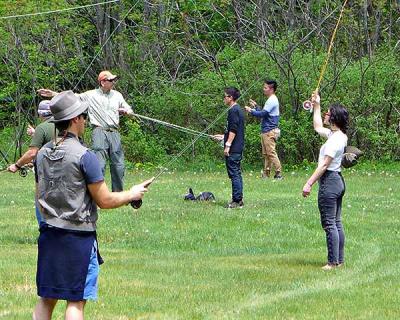From the Mighty Falls

I’m writing this heading back to saltwater from Buffalo and my first-ever visit to Niagara Falls. We crossed into Canada to view the three sections of Gahnawehta, as the Indians called them, to go aboard the vessel Hornblower — the equivalent of the Maid of the Mist from the United States side — to view the cascades from below.
The boat takes you past the relatively tame American and Bridal Falls to a point under the Horseshoe Falls very close to the impact zone where most of the falls’ six million cubic feet of water spill 165 feet every minute from the Niagara River into Lake Ontario. Awesome! The roar was deafening, the spray blinding. That’s a lot of water, actually the highest flow of any falls in the world.
I found myself offering up a silent prayer to Hornblower’s engine. Please don’t fail. The swirling currents of clear green water would surely bring a stalled boat within reach of the impact zone and a wipeout of major proportions. The biggest waves in the world have got nothin’ on mighty Gahnawehta.
Halfway through the 10-hour drive south the next day, we passed over the Susquehanna River on Route 20. The river, one of the longest in the country, flows to the Chesapeake Bay.
Just beyond Fishs Eddy, N.Y., on Route 17, I watched the Beaverkill snake through the Catskills, all light green with new leaf punctuated by the darker green of pines and fir. In places along the banks and in the shallow middle of this tributary to the mighty Delaware, fly casters flogged the surface with serpentine waves of arcing line.
Mid-May is when mayflies hatch from their nymph stage and take on the appearance that fly tiers spend winters attempting to emulate. The Beaverkill is a mecca for casters hoping to commune with the river’s brook trout.
Just off the side road to the Roscoe Diner for lunch, a fly-casting clinic was under way — about three experienced hands telling a dozen neophytes casting into the grass how it’s all in the elbow.
I called Paulie’s Tackle Shop in Montauk from the road to see how the spring migration of our beloved marine species had evolved while I was gone. Glenn Grothmann was at the helm and told me there were plenty of striped bass around. Small stripers were responding to lures cast from the usual early-season spots, Ditch Plain and in among the rocks of the Montauk moorlands. Larger keeper size bass (over 28 inches in length) were falling to clam baits along south-facing beaches from Montauk to Shinnecock.
Hurling baited hooks seaward with a surf rod has always seemed strange to me, but it is a discipline unto itself, a more laid back approach to fishing, more Huck Finn. Stick the rod butt into its sand anchor, sit back and have a beer until the reel screams for your attention.
The more cerebral anglers among us — I’m referring to bait-eschewing saltwater flycasters — are seeking the relatively windless shallows of Three Mile Harbor and the south end of Lake Montauk to sight-cast for meandering striped bass. Reports of large bunker (menhaden) schools bode well for an early season visit by larger striped bass. Bass love bunker.
From the banks of Gardiner’s Bay in Amagansett and Springs you might have seen a large boat nestled in Cherry Harbor on the west side of Gardiner’s Island. It was likely a party boat from Montauk’s Viking Fleet plying a spot known to produce porgies this time of year.
The porgy (scup) season for recreational anglers started on May 1. The bag limit is 30 per day measuring at least 10 inches.
The fluke (summer flounder) season for sport fishermen began on Sunday, and it seems like it’s gotten off to a good start on both bay and ocean sides. The more liberal catch limits that took effect last season are the same, five fluke per day at 18 inches.
Harvey Bennett at the Tackle Shop in Amagansett reported the better fluking in Gardiner’s Bay is taking place around Cartwright Shoals on the southern end of Gardiner’s Island. He said an early and spotty showing of squid seems to have disappeared due to schools of squid-hungry bluefish. Time to get the smokers ready to receive the blues. Remember, the catch limit for bluefish is 15 per day, no more than 10 of which can be “snappers,” that is, measure less than 12 inches in length.
From brook trout to bluefin tuna (the latter reportedly seen off the coast of western Long Island) the fish are migrators either to spawn or to feed, and the prognosis looks good for summer of 2015.
